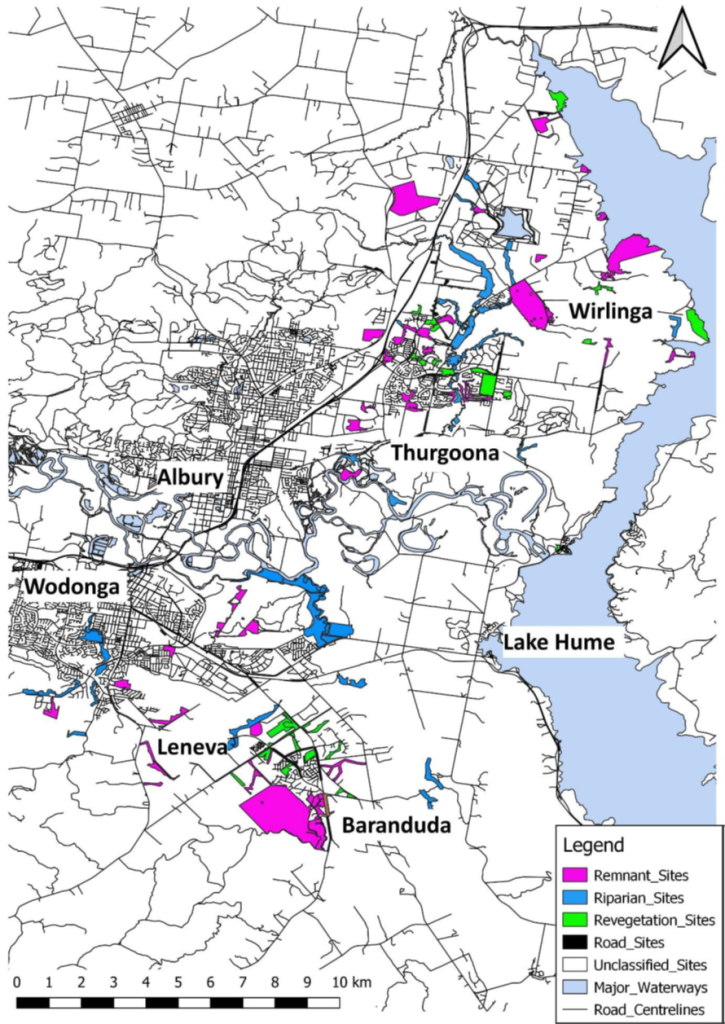Release of 2021 monitoring report
Albury Conservation Company is very excited to release the 2021 Annual Report for our Threatened Species Monitoring Program. The report documents the monitoring of both sides of the Murray River, covering around 120 sites across the main urban growth areas of Albury (NSW) and Wodonga (VIC)

RESULTS – ALBURY (THURGOONA / WIRLINGA), NSW
Two monitoring periods occurred in the Albury study area in 2021, Autumn and Spring. The survey effort in each period was 66 sites and 67 sites monitored respectively. Results showed:
- 30 Squirrel Glider detections in the Autumn monitoring period (detection rate of 45%)
- 25 Squirrel Glider detections in the Spring monitoring period (detection rate of 37%).
This was an increase in overall glider detection rates from the previous year (2020), across Autumn monitoring where the detection rates were 35% (Autumn 2019) and a slight decrease across Spring where the detection rates were 38% (Spring 2019). The 2021 monitoring periods have resulted in four successive monitoring periods with glider detection rates of greater than 35%, after they had previously declined.
RESULTS – WODONGA (LENEVA / BARANDUDA), VIC
Two monitoring periods occurred in the Wodonga study area in 2021, Winter and Spring. The survey effort in each period was 59 sites monitored. Results showed:
- 22 Squirrel Glider detections in the Autumn monitoring period (detection rate of 37%)
- 22 Squirrel Glider detections in the Spring monitoring period (detection rate of 37%)
The 2021 monitoring periods showed an increase in detection rates (37%) from the previous year, where the detection rates were 27% (Winter 2020) and 25% (Spring 2020) respectively
RECOMMENDATIONS:
- Continue implementing the TSMP in both Thurgoona – Wirlinga and Wodonga to improve knowledge of threatened species and identify critical habitats, linkages, and management interventions to ensure the populations remain viable in the face of urbanisation.
- Develop a ‘shovel ready’ spotlight survey project to identify sites with Squirrel/ Krefft’s glider overlap and facilitate the development of a motion sensing wildlife camera identification protocol in early 2022.
- Pursue opportunities to fund further research or projects based on the TSMP data collected to date.
- Prioritise the delivery of the design and delivery of the three-year funded ‘Applying science to on-ground action for conservation of Albury Wodonga’s threatened wildlife’ project.
- Ensure the timely and effective delivery of the ‘Applying science to inform on-ground actions for conserving Wodonga’s threatened wildlife’.
- This program and its associated projects should be supported by Councils and other key stakeholders. It aligns with the Regional Natural Environment Strategy (RNES) and meets many of the actions in the RNES Action Plan (2020-24).
The Albury Wodonga Threatened Species Monitoring Program has been made possible with funding from Albury City Council, Ross Trust, Wettenhall Environment Trust, Wodonga Council and others.
